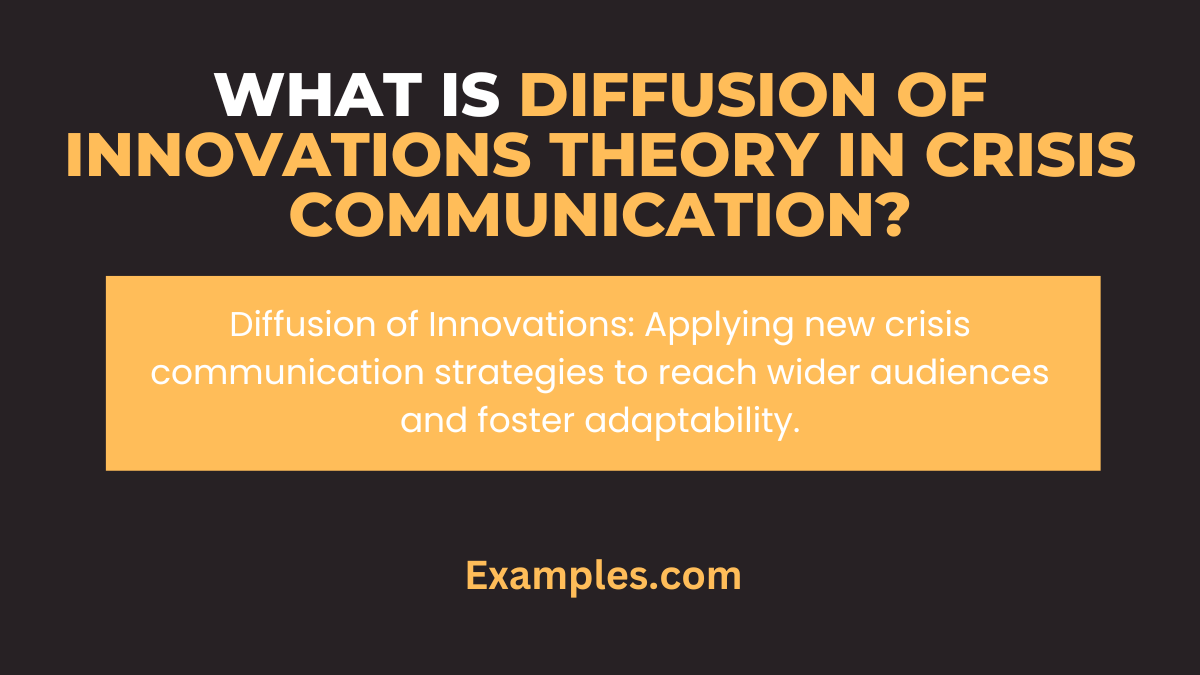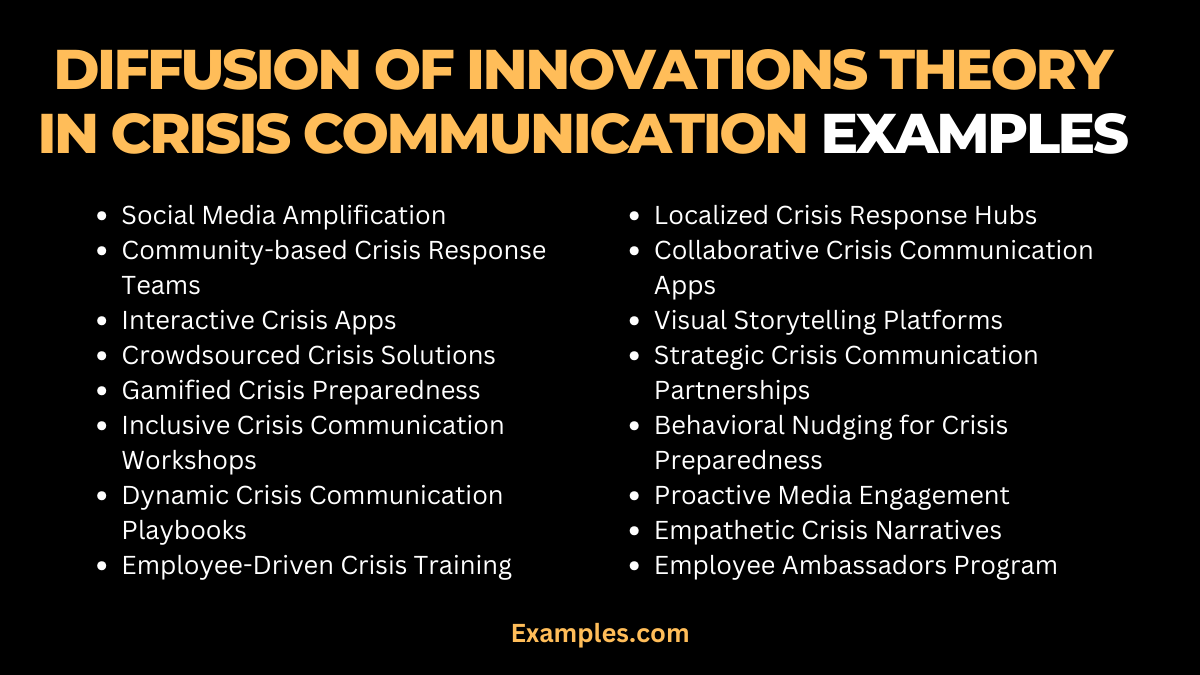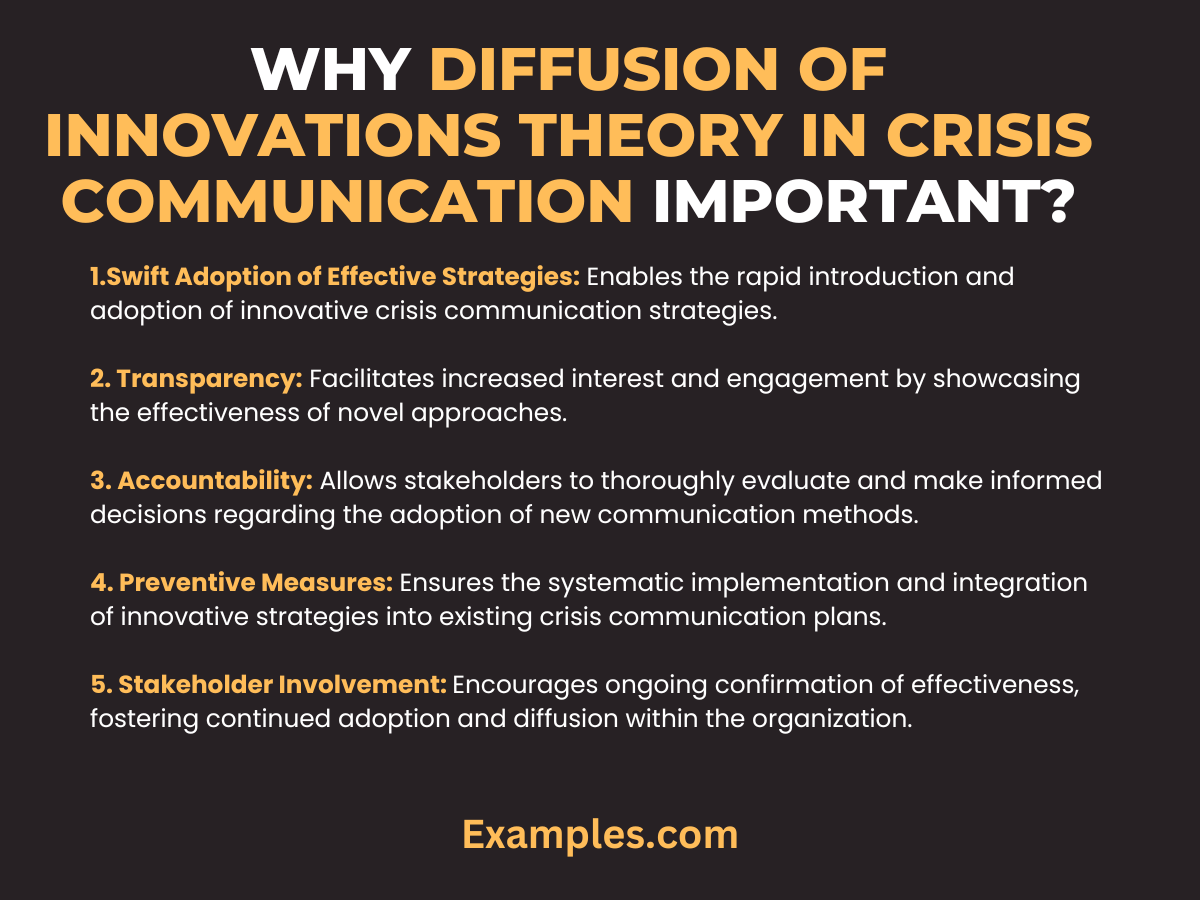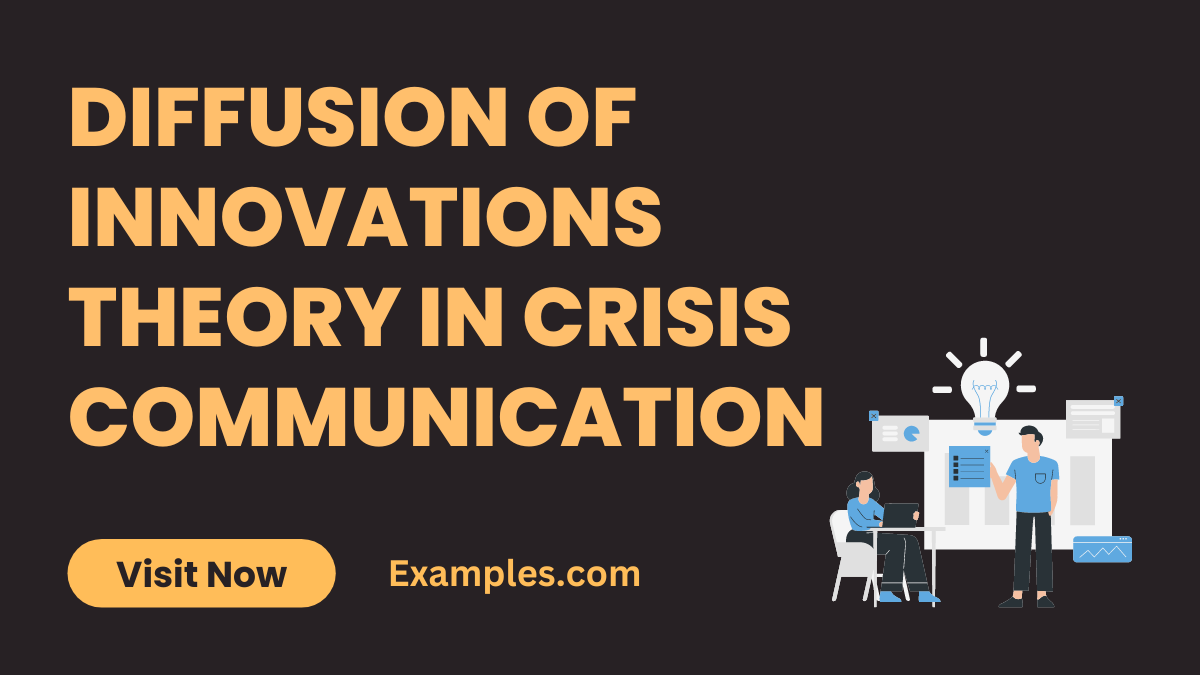19+ Diffusion of Innovations Theory in Crisis Communication Examples
Embark on a comprehensive exploration of Crisis Communication through the lens of Diffusion of Innovations Theory. This complete guide unveils the strategic application of the theory in navigating crises, enriched with real-world examples. Uncover dynamic communication examples that illuminate how innovating crisis response strategies can transform challenges into opportunities. Empower yourself with actionable insights, ensuring a resilient and effective approach to crisis communication using the influential Diffusion of Innovations Theory.
What is Diffusion of Innovations Theory in Crisis Communication?

Diffusion of Innovations Theory in Crisis Communication is a strategic framework that emphasizes how innovations, including communication strategies, spread among individuals or groups during a crisis. In simple terms, it examines how new and effective crisis communication approaches diffuse through a population, influencing and transforming the response to challenging situations. This theory guides communicators in adopting innovative strategies that can be widely accepted and applied during crisis scenarios, fostering effective communication and resilience.
20 Diffusion of Innovations Theory in Crisis Communication Examples

Explore 20 real-world examples showcasing the practical application of Diffusion of Innovations Theory in crisis communication. This curated collection illustrates how innovative strategies have been successfully diffused during crises, providing valuable insights for communicators navigating challenging scenarios with resilience and creativity.
- Social Media Amplification: Innovatively disseminate crisis updates via social platforms, engaging a broader audience for effective information diffusion.
- Community-based Crisis Response Teams: Establish local response teams to swiftly disseminate crisis information within communities, ensuring rapid diffusion.
- Interactive Crisis Apps: Develop user-friendly crisis apps, utilizing technology to swiftly disseminate vital information and enhance community preparedness.
- Crowdsourced Crisis Solutions: Leverage the wisdom of crowds for innovative crisis resolution, encouraging community participation in diffusing effective solutions.
- Gamified Crisis Preparedness: Create gamified crisis simulations, engaging and educating individuals for enhanced diffusion of crisis preparedness strategies.
- Inclusive Crisis Communication Workshops: Host workshops that foster inclusive dialogue, allowing diverse perspectives to shape and diffuse effective crisis communication strategies.
- Dynamic Crisis Communication Playbooks: Develop dynamic playbooks that adapt to changing crisis scenarios, facilitating swift and effective diffusion of communication strategies.
- Employee-Driven Crisis Training: Empower employees as communication advocates, facilitating internal diffusion of crisis communication strategies.
- Localized Crisis Response Hubs: Establish localized crisis hubs that adapt communication strategies based on the unique needs of different regions.
- Visual Storytelling Platforms: Utilize visual platforms for crisis storytelling, enhancing engagement and expediting the diffusion of critical information.
- Collaborative Crisis Communication Apps: Foster collaboration through dedicated apps, allowing diverse stakeholders to contribute to and share crisis communication strategies.
- Strategic Crisis Communication Partnerships: Form strategic partnerships with influencers and organizations to expand the reach and speed of crisis communication diffusion.
- Behavioral Nudging for Crisis Preparedness: Implement behavioral nudges to encourage proactive crisis preparedness actions, ensuring a faster diffusion of safety measures.
- Proactive Media Engagement: Innovatively engage with media outlets, proactively diffusing crisis communication messages through various channels.
- Empathetic Crisis Narratives: Craft empathetic crisis narratives that resonate with audiences, facilitating emotional connection and aiding the diffusion of essential information.
- Community-Driven Crisis Communication Forums: Establish online forums that empower communities to actively participate in shaping crisis communication strategies and ensure widespread diffusion.
- Strategic Crisis Communication Infographics: Develop visually compelling infographics that simplify complex crisis information, facilitating quicker diffusion across diverse audiences.
- Employee Ambassadors Program: Create an employee ambassador program to cascade crisis communication messages internally, ensuring efficient diffusion within the organization.
- Localized Crisis Communication Drills: Conduct localized crisis drills, involving community members in hands-on scenarios to enhance the diffusion of crisis response skills.
- Innovative Crisis Messaging Platforms: Utilize innovative messaging platforms, such as chatbots and AI, to ensure the rapid and widespread diffusion of crisis information and updates.
Diffusion of Innovations Theory in Crisis Communication Example for Business
Discover how Diffusion of Innovations Theory transforms crisis communication in the business realm. This guide unveils unique examples where innovative strategies diffuse effectively, ensuring resilient crisis management and fostering a forward-thinking communication approach.
- Internal Wiki for Crisis Information: Implement an internal wiki, allowing employees to collaboratively access and update crisis information in real-time, fostering swift diffusion.
- Blockchain for Supply Chain Crisis: Leverage blockchain to enhance transparency in supply chain communication during crises, ensuring a secure and rapid diffusion of critical information.
- Predictive Analytics for Market Shifts: Utilize predictive analytics to forecast market shifts during crises, facilitating timely communication and swift diffusion of strategic responses.
- Customer-Driven Product Solutions: Engage customers in co-creating crisis-responsive product solutions, ensuring a rapid and wide diffusion of innovative offerings during challenging times.
- Strategic Crisis Communication Chatbots: Implement chatbots equipped with crisis communication strategies, ensuring 24/7 availability and facilitating the quick diffusion of essential information.
What are Stages of Diffusion of Innovations Theory in Crisis Communication?
Understanding the stages of Diffusion of Innovations Theory in Crisis Communication is crucial:
- Innovation Introduction:
- Introduce innovative crisis communication strategies.
- Outline the benefits and uniqueness of the approach.
- Interest Development:
- Garner interest by showcasing the effectiveness of the innovation.
- Provide real-world examples illustrating successful diffusion.
- Evaluation by Adopters:
- Allow stakeholders to evaluate the innovation’s suitability.
- Encourage feedback and address concerns.
- Decision to Adopt or Reject:
- Stakeholders make informed decisions to adopt or reject.
- Highlight the advantages and address potential challenges.
- Implementation and Integration:
- Implement the innovation systematically.
- Integrate it into existing crisis communication plans.
- Confirmation and Continued Adoption:
- Confirm the effectiveness through feedback.
- Foster continued adoption and diffusion within the organization.
Why Diffusion of Innovations Theory in Crisis Communication Important?

The significance of Diffusion of Innovations Theory in Crisis Communication lies in its:
- Swift Adoption of Effective Strategies: Enables the rapid introduction and adoption of innovative crisis communication strategies.
- Enhanced Stakeholder Engagement: Facilitates increased interest and engagement by showcasing the effectiveness of novel approaches.
- Informed Decision-Making: Allows stakeholders to thoroughly evaluate and make informed decisions regarding the adoption of new communication methods.
- Efficient Implementation: Ensures the systematic implementation and integration of innovative strategies into existing crisis communication plans.
- Continuous Improvement and Adoption: Encourages ongoing confirmation of effectiveness, fostering continued adoption and diffusion within the organization.
How Diffusion of Innovations Theory in Crisis Communication can be Applied?
Practical application involves:
- Identifying Innovative Strategies: Recognize novel crisis communication approaches that align with the organization’s goals and challenges.
- Customizing for Context: Tailor innovative strategies to suit the specific context of the crisis, considering factors such as audience, nature of the crisis, and organizational culture.
- Engaging Stakeholders: Actively involve stakeholders in the decision-making process, seeking their input and feedback during the evaluation and adoption phases.
- Communication and Training: Communicate the benefits and features of the innovative strategies clearly. Provide necessary training to ensure stakeholders are proficient in their implementation.
- Piloting and Scaling: Begin with small-scale pilot implementations to assess effectiveness. Based on feedback and results, scale up successful strategies for broader application.
- Feedback Mechanisms: Establish robust feedback mechanisms to continuously gather insights from stakeholders. Use this feedback to refine and enhance the adopted crisis communication innovations.
- Integration with Existing Plans: Ensure seamless integration of innovative approaches into existing crisis communication plans, fostering a cohesive and comprehensive strategy.
- Continuous Evaluation: Implement continuous evaluation mechanisms to assess the ongoing impact and relevance of the adopted innovations, allowing for adjustments as needed.
How is the Diffusion of Innovations Theory in Crisis Communication Useful?
The utility of this theory is evident in:
- Adaptive Strategies: Provides a framework for introducing and adopting adaptive crisis communication strategies, ensuring organizations stay responsive to evolving challenges.
- Effective Stakeholder Engagement: Facilitates increased engagement by effectively communicating the benefits and successes of innovative crisis communication approaches.
- Informed Decision-Making: Empowers stakeholders to make informed decisions about the adoption of new communication methods, fostering a sense of confidence and involvement.
- Efficient Implementation: Guides the systematic implementation and integration of innovative communication strategies, optimizing the efficiency of crisis response efforts.
- Continuous Improvement: Supports ongoing evaluation and confirmation of the effectiveness of adopted strategies, encouraging a culture of continuous improvement.
In conclusion, this comprehensive guide has illuminated the transformative power of Diffusion of Innovations Theory in Crisis Communication. Through real-world examples and strategic insights, communicators are empowered to innovate and navigate crises effectively. Embracing this theory ensures organizations not only respond resiliently but also thrive amidst challenges, fostering a culture of continuous improvement and adaptive crisis communication.



